DO-IT News October 2015

Volume 23, Issue 4
Below are the articles of the DO-IT News October 2015 newsletter. These articles can also be seen all on one page at the Full Newsletter option.
Director's Digressions: DO-IT in Thailand
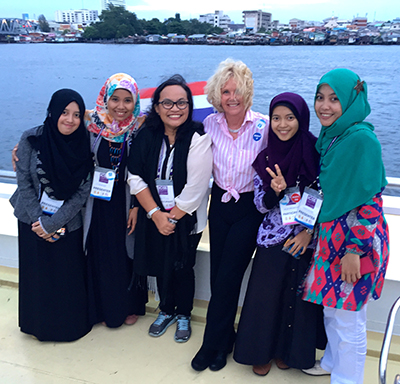
I recently took an exciting trip to the First International Conference on Special Education in Bangkok. It took 16 hours to get there by air. Although focused on Southeast Asia, there were more than 30 countries represented for a total attendance of 1500. It was a long way from home, but well worth it to hear about and share innovative practices in special education. I gave a keynote presentation, “Innovations That Lead From Inclusive Education to an Inclusive Society” and a workshop “Adaptation and Replication of DO-IT Practices.”
In both talks I emphasized the importance of working with students with disabilities (e.g., to develop self determination skills) and the universal design of products and the institutional environments with which they interact (e.g., instruction, services, physical spaces, technology). My talks generated rich discussions about practices in Southeast Asian countries and beyond.
DO-IT practices have been adapted and replicated in Japan at the University of Tokyo and Malaysia at the University of Malaya. We also have strong connections and have shared practices in South Korea. Anyone interested in creating a DO-IT Center should consult the publication titled Replication and Adaptation of DO-IT Practices and email me at sherylb@uw.edu.
DO-IT Awarded Three New Grants
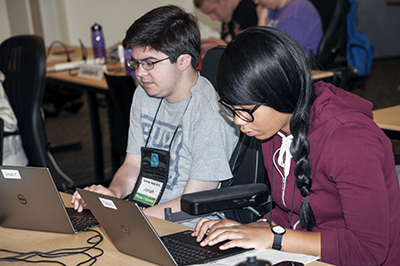
The National Science Foundation (NSF) recently approved three new grants. The new AccessCyberlearning project will address disability-related issues to help researchers and educators make online learning experiences more effective and accessible to students with diverse characteristics. AccessCyberlearning will spend two years increasing the capacity of current and future NSF-funded cyberlearning projects to design innovative learning technologies, teaching strategies, and project activities that are welcoming to, accessible to, and usable by all participants, including students with disabilities.
The second new grant is an additional investment of almost four million dollars to AccessComputing, a project that has been ongoing for a decade. AccessComputing will continue to increase the number and success of people with disabilities in computing degree programs and careers, as well as increase the capacity of postsecondary institutions to fully include students with disabilities in computing courses and programs. Added to PI, Professor Richard Ladner, UW Department of Computer Science and Engineering, and CO-PI Dr. Sheryl Burgstahler, DO-IT Director and Affiliate Professor in the College of Education, are Co-PIs Professors Amy J. Ko and Jacob Wobbrock from the UW Information School. This new connection will bring strengths in human-computer interaction, ability-based design, computing education, mobile user interfaces, and computer input methods. AccessComputing will also include a new group of industry affiliates to bring greater focus on placing students with disabilities into computing careers.
Lastly, The Center for Neurotechnology (CNT) received supplemental funding to conduct AccessERC. CNT is part of the network of more than a dozen Engineering Research Centers (ERCs) supported by NSF. With Raj Rao, a faculty member in the UW College of Computer Science and Engineering, as PI and DO-IT’s Sheryl Burgstahler as Co-PI, AccessERC staff will engage with other ERCs to make their activities and products welcoming to, accessible to, and usable by people with disabilities. AccessERC staff will conduct training, consultation, and collaborative activities, as well as develop and deploy resources to help current and future ERCs work toward reaching project goals.
AccessEngineering Invites DO-IT Scholars to Solve Accessibility Problems in UW CoMotion Makerspace
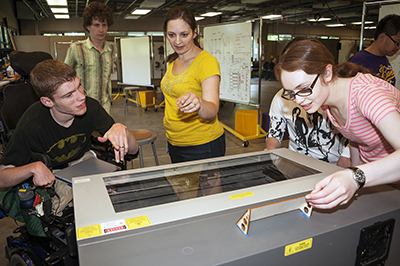
In July, as part of an AccessEngineering activity, a group of DO-IT Scholars visited the University of Washington (UW) CoMotion Makerspace to partake in a prototyping challenge and discuss accessibility challenges in the space. A makerspace is designed to encourage innovation and allow people to tinker and create, making available a variety of tools and equipment, including 3D printers, laser cutters, hand tools, and sewing machines. Many universities, libraries, and other organizations are setting up their own makerspaces, making this an ideal time to encourage universities to ensure these spaces are accessible to individuals with disabilities.
Through their visit, the Scholars provided feedback that was used to refine DO-IT’s online publication, Making a Makerspace? Guidelines for Accessibility and Universal Design. These guidelines will be widely shared with universities across the country. In addition, UW CoMotion Makerspace was able to upgrade the accessibility in their space to allow more students with disabilities to feel comfortable creating in the makerspace.
UW Today reported the story, “How Makerspaces Can be Accessible to People with Disabilities,” featuring the discussions among the group and the upgrades suggested. NSF shared the article on their website and tweeted it to almost 700,000 followers.
KUOW also covered the story, “UW Courts Students With Disabilities To Engineering Field With New MakerSpaces,” with interviews with Kat Steele, co-PI of AccessEngineering, and one of the DO-IT Scholars involved in the project.
Another story by King 5 News, included an interview with Kat Steele and another one of the DO-IT Scholars. The feature can be seen on the King 5 website. Learn more about AccessEngineering activities online.
Summer Study: What Do Phase I Scholars Do?
DO‑IT Phase I Scholars participate in a two-week, live-in Summer Study session on the UW Seattle campus. They learn about college life; explore the Internet; interact with peers, staff, and mentors; and have fun. The DO‑IT Scholars program started in 1993 as an experimental project for teens with disabilities nationwide. It is currently open to Washington State teens and is supported by the State of Washington, the Boeing Company, the Microsoft Corporation, and the National Oceanic and Atmospheric Administration.
Exploring Microsoft
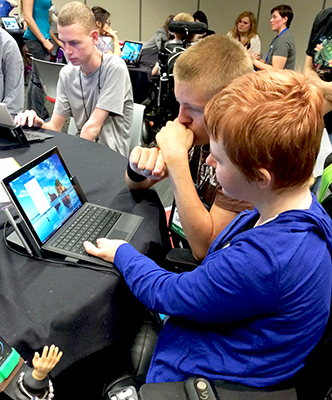
On the first Friday of Summer Study, we took a tour of Microsoft, led by Sean Marihugh and Chris Schlechty, two DO-IT Ambassadors that work for Microsoft. During the tour, they stressed self-advocacy and universal design for Microsoft products.
Our first activity was a demonstration of Eye Gaze technology. Eye Gaze is a program that allows people to use technology, move around, and communicate using only their eyes. For this activity, a tablet was hooked up to the Eye Gaze camera, and each of us played a game.
After that, there was a panel of employees with various disabilities. We had a Q&A session, and they spoke about self-advocacy and getting accommodations in the workplace.
We were also introduced to the new Windows 10 operating system. It was quite fascinating, as the computer allowed us to draw on webpages and talk to a personal assistant named Cortana. This was our favorite part, because new technological advancements have always excited and inspired us.
Next, we participated in a team activity to design a robotic companion, including features, name, slogan, and price. Everyone created a worthy product, and we got to see a wide variety of great ideas. After the designs were completed, we concluded our visit to Microsoft. It was a great experience, and one that we will not forget.
Celebrating A Birthday With DO-IT
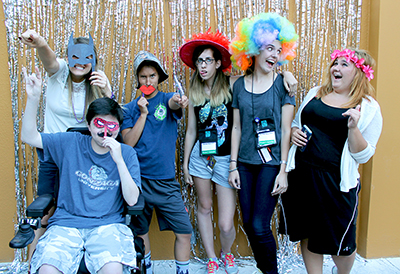
Katelyn’s perspective: How could you celebrate a birthday for someone you barely knew? I didn’t know until now. It’s one thing to just say “happy birthday,” but learning all about someone to celebrate your roommate’s birthday was fun. The first thing we did was help find the perfect birthday outfit. Many people like to dress up in a fancy outfit for their birthday, and Hailey definitely did. We also asked staff if we could get her a special treat, like a cupcake or special coffee. Just let them know that today is special even though they can’t be with their family and friends—they have new friends!
Hailey’s perspective: I had my first time being away from home on my birthday. It ended up being a great day. We went to Microsoft. In the evening, other Scholars got me a cupcake and sang me happy birthday. The best part of my birthday was that people wished me a happy birthday all day! By going to this program, I’ve learned not to be scared to tell people about my disability; it feels great knowing I am not the only one. I learned something this year on my birthday away from home and family—I suddenly knew it was time to be myself and not to let it bother me if others say anything about me being different.
Wrestling
Aspen: I never thought about wrestling until the wrestling coach approached me freshman year and told me to check out pre-conditioning. Two weeks later, I decided to try it out, and, before I knew it, I fell in love with the sport and ended up being on the team.
Tasha: I have been wrestling for five years. I started because one of my good friends came up to me and asked me to join so she wouldn’t be the only girl on the team. I wanted to try something new, and I ended up loving it! Now wrestling is the main sport I do every year.
Aspen: Being deaf affects my playing because I can’t wear my cochlear implant during practices or matches. This means I can’t hear what my coach is trying to tell me what to do and it’s very hard to concentrate on the interrupter. On the other hand, I am easily able to drowned out the crowd noise and additional unnecessary noises as well. Because deafness had caused me to be more aware of my surroundings and be more sensitive to what I am feeling, I am easily able to make the next movement based off sight and vibrations.
Tasha: Wrestling is a hard sport, and it doesn’t help when you have a disability. I have sickle cell. Sickle cell disease is an inherited blood disorder that causes red blood cells to break down. Having sickle cell makes is hard for me to do some of the wrestling workouts and go on long runs in the cold, because I end up in a lot of pain. This can cause me to miss school if I have to stay home and heal. However, I love the person I am, even if sickle cell helped make me who I am.
Aspen and Tasha: Wrestling is a difficult and challenging sport. It’s hard finding girls that want to be on the team and compete. We try to inspire other girls to be on our teams by talking with them and discussing their worries. We like to share our wrestling success stories and challenges. Wrestling can be challenging, especially eating the right amount to stay in your own weight class. However, wrestling can make you stronger and feel very accomplished.
The Pacific Science Center
Shortly after breakfast on Saturday, we hopped on the bus to go to the Pacific Science Center in Seattle. We first went to the IMAX theater for the movie Humpback Whales 3D, and we both enjoyed it. One thing we learned was the way the whales communicated with each other to capture fish for food. Many humpback whales surround the fish and blow bubbles, while others dive deep in the water so they can drive the fish towards more shallow water. This bubble net technique allows them to swallow thousands of fish in one gulp.
After the movie, we ate lunch outside the café. We then looked at a few small exhibits on our way to the laser dome for the Michael Jackson Laser Show. The laser show was cool because the lasers were shaped in ways that fit well with the Michael Jackson songs that were playing.
We split into groups and went to the rest of the exhibits. We visited the butterfly area and then explored the Grossology exhibit, which features facts about the human body. Finally, we visited the current research exhibit, where we were able to see an UpTempO buoy, which is what Dr. Mike Steele and his team use for polar ocean temperature research. This was great to see, since he was also the presenter for our Summer Study oceanography class.
After a busy day exploring and learning at the Pacific Science Center, we travelled back to the UW campus in time for dinner.
Having a College Roommate
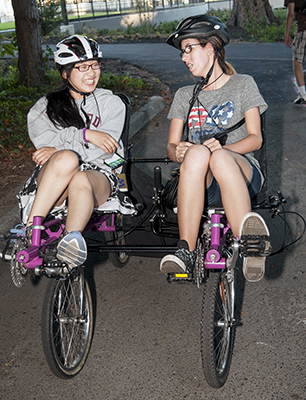
After a long journey to the wonderful University of Washington campus, learning about the dorms, and meeting some of the Scholars, you still have one more adventure to attend to before dinner and rest. This is meeting your new roommate. Having a roommate is very interesting, especially when it’s your first time living in a dorm, and it gives you a connection and friend throughout Summer Study. Your roommate is probably just as excited and nervous about DO-IT Summer Study as you are.
As nice as it is to have a roommate, you still want to keep a few small things in mind. Remember to respect and be nice to each other, communicate, and look out for each other. You are both new at this and could use an ally. It’s important that you and your roommate help each other and remember you both have different strengths and weaknesses. Hold the door open, pick things up for each other, and walk to your next activity together if possible. Also be there for your roommate to talk to if they need emotional support. If you and your roommate are respectful to one another then you will become fast friends.
Sporting Events And Accessibility
Going to sporting events in Seattle is an amazing experience that will give you everlasting joy, but there are some challenges people with disabilities face when attending.
One main obstacle faced when going to sporting venues is their accessibility of seating. There are only a few wheelchair specific seats available around CenturyLink Field. If you plan on transferring out of your walker/wheelchair, there aren’t specifically allocated places where you can leave your equipment in eyesight. However, staff can take your equipment to a storage room and return it to you during half-time or as requested.
An obstacle faced by people who find it hard to hear is that there is no captioning on any of the monitors located inside the stadium, which means that you can’t get the full game experience that everyone should be entitled to.
CenturyLink field did have great staff members who provided assistance. They wanted to make sure we had a positive experience, so they made everything as accessible as they could.
What the DO-IT program has taught us is that we need to be self-advocates for what we need, and that it is okay to ask for accommodations or help. Our disabilities do not define who we are or what we do.
Karaoke Night
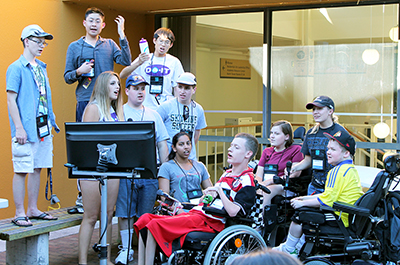
We both really enjoyed karaoke night! The song selection was unparalleled to any we have seen--the binder full of songs is about four inches thick! It even featured songs from musicals, which was an exciting surprise, since many of the students this year really like musicals. We also loved karaoke night because of the culture of acceptance DO-IT promotes. Even if you were a bad singer, it was easy to go up and have a good time, and there was a lot of positive support from everyone.
Another great part of karaoke night was sharing a love of music with everybody through voice. Even when you love to sing, you don’t get to show it off often. By the end of the night, some of our throats were sore from all the singing. We can’t wait for next year’s karaoke night!
How to Roll in Scooter Style
Whenever we roll through a crowd of able bodies, the looks on their faces read, “Why are they so cool, and we’re not?” Naturally, we know that they are jealous of our hot rides. The scooter is like the limo of the accessible fleet: Long and hard to drive, but surprisingly comfortable. Here are our top three tips on how to roll through life in style.
- If someone’s staring, stare back. This can make people feel awkward and look away.
- Don’t be afraid to toot your own horn. This can be helpful to tell people they are in your way. The horn is not your enemy, it’s your best friend!
- If you need something, say something! You are your best advocate. A little sass can translate into a lot of class. You have a disability—use it to your advantage!
Summer Study: What Do Phase II Scholars Do?
Phase II Scholars return to the UW Seattle campus for their second Summer Study. They meet the Phase I Scholars, learn about college life and career preparation, and participate in a one-week workshop with postsecondary instructors.
Reel Grrls (and Guys, too!)
This year, five of the Phase II Scholars took part in producing their own short videos. In collaboration with Seattle-based Reel Grrls, an organization mainly for girls to feel empowered and discover their potential through media production, our students planned their own stories, learned film techniques, investigated how disability is portrayed in the media, and edit video footage.
We started our workshop with a presentation on the Disability Rights Movement. The purpose of this presentation was to give us a background on the negative stereotypes associated with of people with disabilities, along with the medical and social models of disability. We also watched videos related to disability rights, such as comedian Stella Young’s TED Talk on people with disabilities as objects of inspiration, an episode of a video series called, “My Gimpy Life,” and various notable clips featuring people with disabilities in movies.
At the same time, we developed basic abilities to record and edit videos through mobile devices, including the iPod Touch and the iPad. We learned the different types of shots, such as wide-shot, medium shot, and close-up. The purpose of these videos was to convey a message regarding a stance on disability and an issue, guided by the creator’s story.
Visiting the CoMotion MakerSpace
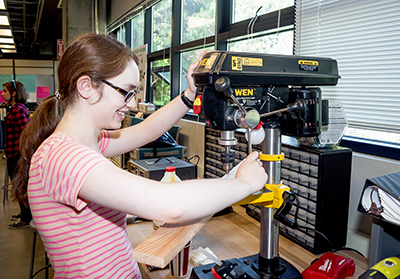
Need a place to build, as well as get inspired and find your creativity? The CoMotion MakerSpace is the right place for you. The CoMotion MakerSpace at the University of Washington (UW) is a place built for UW students and the UW community to freely express their ideas and collaborate to create projects together. As DO-IT Interns, we were invited to go and experience the opportunities at the makerspace.
On the first day, we made a prototype of our ideal wallet. We worked in groups to sketch a design, and we interviewed each other on how an ideal wallet would look and function. The challenge to the activity was a 10-minute time limit and a limited amount of materials; we could only use cardboard, straws, paper clips, tapes, sticky notes and blank papers.
After the challenge, we discussed how we could make current and future makerspaces more accessible to people with disabilities. We brainstormed positive and negative aspects about the accessibility of this makerspace. One positive was that most tables and whiteboards in the workstation area used wheels, which make it easier for wheelchair users to move around in the large space. On the other hand, one of the problems was that some of the tools provided for students may not be accessible for students with disabilities, especially wheelchair users. There were also no large prints or braille signs to help people who have a visual impairment. As a group, we came up with ideas of what kind of improvements the CoMotion MakerSpace needs to improve its accessibility.
We are really excited and looking forward to see the improvements we came up with to improve accessibility for future makerspaces so both able-bodied and people with disabilities can collaborate.
[Note: A checklist for making an accessible makerspace can be found on the DO-IT website.]
Robotics
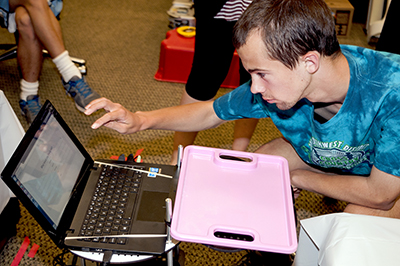
The picture most people have of a robot comes from science fiction movies. Robots are generally seen as futuristic entities that can gain self-awareness at any time. In general, robots are programmed to perform certain tasks, have partial autonomy, and have at least two degrees of freedom. A microwave oven or a cell phone could arguably be considered simple robots.
Maya and Sarah ran the robotics workshop. We worked with robots named Chester, a TurtleBot, and Rosie, a PR2. Rosie was large, had arms that moved in many directions, and numerous cameras with varying ranges. Chester was much smaller, did not have arms, and used an Xbox Kinect as a camera. The Scholars discussed ideas for a scenario to conduct using the robots, deciding on a restaurant scene. Chester was the waiter and Rosie was the chef. Chester was programmed with the programming language Python. We programmed it to greet and seat the guests, take orders, deliver food, and collect payment.
Everyone learned something, even the Interns. Mike and Kennedy were proud to say that they learned just as much from their programming failures as they did from their programming successes. Vanessa enjoyed the experience of working with real-life robots. Jason liked the challenge of programming, and Sangha enjoyed coming up with real-world applications for the robots. The greatest takeaways were lessons in teamwork, programming, and real-world applications of robotics. We greatly appreciate all the time and effort the workshop leaders put into making this experience possible.
Exploratory Neurobiology
Martha Bosma studies the spontaneous calcium activity in embryonic mouse and chick brain stems, analyzing spontaneous electrical activity in nervous system development. While the lab was fairly accessible, two Phase I Scholars had difficulty accessing high-placed equipment and fitting through the narrow aisles. These issues could be solved with small adjustments in the lab.
The Scholars experimented with mice embryos and cockroaches. They saw how nicotine and other drugs affected the mouse’s heart reactions and the cockroach’s leg and spine movements. Scholars learned how to identify axon potentials and to graph patterns for calcium channel reactions. By the end of the workshop, Scholars learned the inner workings of neurons in real time.
Summer Study Highlights
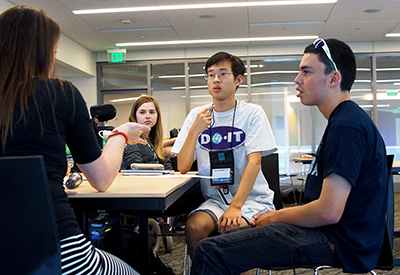
It was truly a privilege and an honor to serve as a DO-IT Intern at Summer Study this past July. Having gone through the program in previous years as a Phase I and Phase II Scholar, I gained invaluable skills and support that have been vital to my success as a student and as a person. I jumped at the opportunity to pass down my newly-acquired knowledge to the new Scholars. We participated in countless activities throughout the 10-day experience; here are a few highlights:
- Scholar/Intern panel—I enjoyed being able to answer the Scholars’ questions and provide them with advice with regard to navigating college life with a disability.
- Visits to the Pacific Science Center and Woodland Park Zoo—It was fun seeing the exhibits and hanging out with everyone.
- Resume workshops/mock interviews—Having gone through the employment process, I was able to share with the Scholars my experiences, simulate real-world situations and offer them tips on how to “sell themselves” to employers.
Overall, Summer Study was an outstanding success. I sincerely hope everyone involved (Scholars, Interns, and Staff) uses this experience to grow and pave new paths for themselves. I will continue to do my part to improve myself and strengthen the connections within the DO-IT family.
Supporting Phase I and II during DO-IT Summer Study
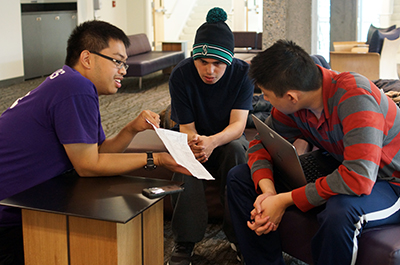
For most of the Interns, the job of looking after the Phase I and Phase II Scholars seemed like a lot of responsibility. We quickly learned that teamwork would help get all tasks done much more efficiently. While it was overwhelming at first, it became easier as days went by. Interns had a lot of fun getting to know Scholars while also learning how to be professional and communicate well with Scholars and staff about needs. The Interns served as mentors for the Phase II Scholars.
Phase I of Summer Study allows new Scholars to meet each other and engage in a variety of interesting activities. However, living on campus for 10 days can feel a bit overwhelming. To ensure that everyone had a good time, the 13 Summer Study Interns helped make students feel comfortable and included. The Interns answered questions about college life and checked in with Scholars to see if they were okay or needed something.
Meanwhile, Phase II Scholars were given the opportunity to become more independent. These Scholars worked in small groups to create a robot, film a video, and conduct experiments that focused on mice, brains, and bugs. Interns were available to support and assist when requested. Phase II Scholars also took part in sessions related to college success; how to interview for a job; how to ask for accommodations in college; and how to write a successful elevator pitch. The Interns encouraged Phase II Scholars to interact with the Phase I Scholars by asking them to share their experiences.
The sense of inclusion is crucial to ensuring a friendly atmosphere to grow during DO‑IT Summer Study. To help create this atmosphere, the Interns encouraged Scholars to participate in leisure activities with each other, such as table tennis or board games in the dorm, bowling in the HUB during game night, or to try something new like riding accessible bikes provided by Outdoors for All. While living in the dorm throughout Summer Study, the Interns helped ensure that the dorm felt a bit more like home.
After DO-IT Summer Study, Scholars, staff, and the DO-IT community engage in a discussion list related to disability. All Scholars and Ambassadors are encouraged to participate in DO-IT discussion lists.
DO-IT Scholars at the Youth Leadership Forum
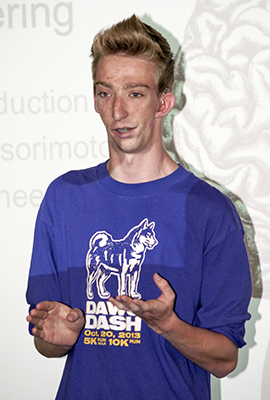
The Youth Leadership Forum (YLF) is a unique career leadership training program for high school juniors and seniors. By serving as delegates from their communities, students can cultivate leadership skills. This year, the 14th annual YLF took place at Western Washington University (WWU) from July 26–31. DO-IT Ambassadors and staff contribute in many ways to the planning and execution of YLF. Ambassadors applied the skills they gained as DO-IT Summer Study Interns, college students and professionals to contribute to the future success of YLF participants.
Brandon Muller, ’01 Scholar, reconnected with the Governor’s Committee for Disability Issues and Employment after receiving his master of education in counseling and was recently appointed to this committee after volunteering the past two summers as a member of the YLF planning committee as well as a counselor. This year, he served as the co-vice chair of the YLF sub-committee.
Melissa Niklason, ’07 Scholar, has been a delegate, peer counselor, and co-counselor in past years. This year, she returned as a lead counselor as she completes her last year of college at Central Washington University. Her biggest contribution has been to share her experiences with other people with disabilities. “There are a lot of people with disabilities who might not want to do certain things because they might be hard for them. I like to think that I am able to make them believe, ‘If she could succeed in doing this, so can I.’” Her favorite moments are “seeing students who, before coming to YLF, were uncomfortable with their disability, become comfortable in their own skin. I see a light bulb going off in their head and a weight being lifted from their shoulders. They realize that there are others in a similar situation, and they can relate.”
Alex Quarrell and Allison Sullivan, ’12 Scholars, were co-counselors. Alex says he learned a lot himself during the program. “One thing that stood out is how to be an effective counselor/mentor even if it’s just being there to talk to when someone needs it so that everyone feels included. I learned the need to be flexible in any situation that might arise.” Allison shared her college experiences, both positive and negative, with the group.
Daman Wandke, ’05 Scholar, has been involved with YLF in the past and returned this year as a speaker and mentor. He presented “My Leadership Journey: From Local to National Advocacy,” where he discussed how he became a disability advocate at the national level. His favorite moment was when he convinced a shy student to join in at the dance. “The student was sitting quietly by himself and after lots of encouragement, I was able to convince him to dance.”
Noah Seidel, ’05 Scholar, and Tami Tidwell, DO-IT program coordinator, organized a panel of mentors and self-advocates to share their experiences with post-secondary education and transition services for high school students. The panelists’ education ranged from transition students to graduate degree recipients. The participants discussed how they decided what they wanted to study, life after high school, and how they were able to request and use accommodations.
The Thread: "Helpful" Strangers
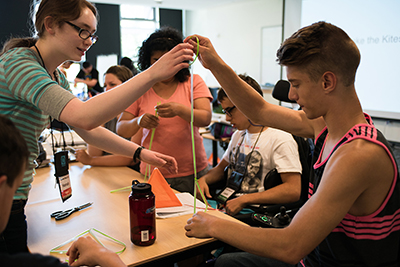
I wanted to share with you a question posed by DO-IT staff in our Internet discussion forum and some of the responses so that you can get the flavor of the many rich conversations the DO-IT community has online. Forum posts are edited for clarity and brevity.
I read the article “8 ‘Helpful’ Things That Don’t Really Help People With Disabilities” based on a Reddit forum post recently, and I wanted to ask your opinion: Do you agree with the comments in the article? Can you think of more examples of “helpful” things that people do that don’t really help?
DO-IT Ambassador: Having to deal with the same conversations and say the same thing time and time again gets annoying.
DO-IT Scholar: I really hate people asking questions. I get that people are curious, but I would prefer if people just saw me as a person.
DO-IT Scholar: The one that resonates with me the most is people giving help when I do not need it. This perpetuates the misconception that I am helpless.
DO-IT Ambassador: In my opinion, it’s okay if a person kindly asks if someone with a visible disability needs help. However, if they continue to “help” even after I’ve said no, then they are just selfishly trying to make themselves feel good. It is very disrespectful.
DO-IT Ambassador: I think people help because they don’t understand. People usually do not even ask me before they start helping.
DO-IT Mentor: I agree. One thing I find difficult to deal with is when people try to hold me when I ascend/descend a bus, train, or aircraft. I have to politely ask them to leave me alone, because I know how to coordinate myself. If others try to assist me while I explore my surroundings, I lose my balance and trip. If I need help, I always ask.
At airports, people try to make me sit in a wheelchair and take me to my aircraft. I tell them I prefer to hold onto one’s elbow. If they insist on the wheelchair, I tell them to sit in the chair and I would gladly push the chair for them as they guide me! One time, a guy apologized as he saw how capable I was. I said, “it’s not about me being capable. We all are humans and deserve to interact with one another in a respectful way.” Experience has shown me that being witty boosts my spirits when dealing with these things.
DO-IT Ambassador: Often when people are told I need assistance, they just assume wheelchair instead of guide. I think there should be some sort of mandatory training for airport staff. But if people try to help me thinking I am helpless, then I get mad.
DO-IT Ambassador: I don’t think people are consciously aware that what they do is selfish, but if you ignore the wishes of a person with a disability, then it stops being helpful.
DO-IT Staff: I always assumed the use of wheelchairs at airports for people with vision impairments was for the airline staff, so they could go as fast as they want and not be slowed down with guided walking. I assume, in many cases, they know better, but really don’t care. I can even imagine them thinking “Hey, I am getting you to your spot as fast as possible--how thoughtful of me,” and “We do it for safety reasons.” Both of those thoughts, of course, are condescending and rude.
UDHE Second Edition Published
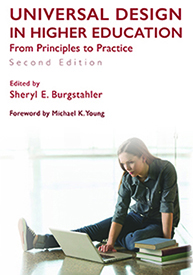
DO-IT is excited to announce the publication of Universal Design in Higher Education: From Principles to Practice, edited by DO-IT Director Sheryl Burgstahler. After thorough revision and the addition of new articles, this second edition addresses recent changes in law, technology, and university policy, making it a fully comprehensive guide for creating inclusive college and university programs.
Universal Design in Higher Education: From Principles to Practice showcases practices for creating a campus environment that is welcoming, accessible, and usable. As more students with disabilities attend postsecondary educational institutions, universal design becomes a practical approach for educators to fully include these students.
To learn more about the book or order it online, visit the Harvard Publishing website. To receive a promotional 20% off, see our special promotional flyer, available until January 2016.
As Stephan Smith, executive director of the Association on Higher Education And Disability, said: “Fresh, comprehensive, and engaging, Universal Design in Higher Education is expertly written, thoughtfully crafted, and a ‘must-add’ to your resource collection.”
About DO-IT
DO-IT (Disabilities, Opportunities, Internetworking, and Technology) serves to increase the successful participation of individuals with disabilities in challenging academic programs and careers, such as those in science, engineering, mathematics, and technology. Primary funding for DO-IT is provided by the National Science Foundation, the State of Washington, and the U.S. Department of Education.
For further information, to be placed on the DO-IT mailing list, request this newsletter or other materials in an alternate format, or make comments or suggestions about DO-IT publications or web pages, contact us at
DO-IT
University of Washington
Box 354842
Seattle, WA 98195-4842
doit@uw.edu
www.uw.edu/doit/
206-685-DOIT (3648) (voice/TTY)
888-972-DOIT (3648) (toll free voice/TTY)
509-328-9331 (voice/TTY) Spokane
206-221-4171 (fax)
Founder and Director: Sheryl Burgstahler, Ph.D.